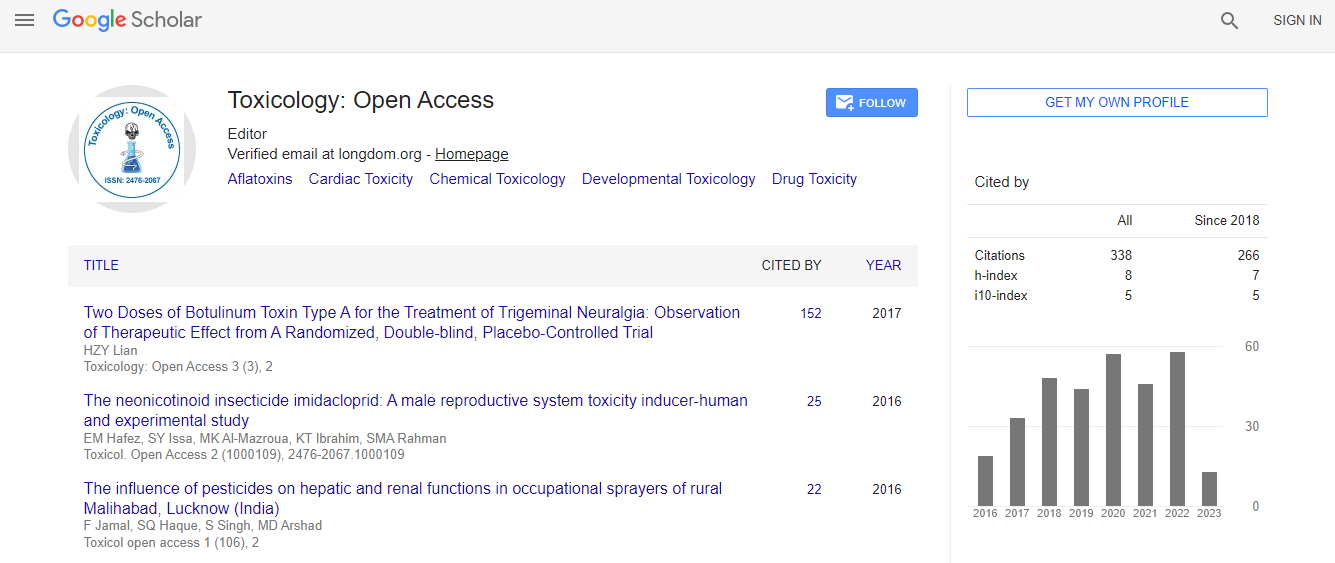Our Group organises 3000+ Global Conferenceseries Events every year across USA, Europe & Asia with support from 1000 more scientific Societies and Publishes 700+ Open Access Journals which contains over 50000 eminent personalities, reputed scientists as editorial board members.
Open Access Journals gaining more Readers and Citations
700 Journals and 15,000,000 Readers Each Journal is getting 25,000+ Readers
Google Scholar citation report
Citations : 336
Toxicology: Open Access received 336 citations as per Google Scholar report
Indexed In
- Google Scholar
- RefSeek
- Hamdard University
- EBSCO A-Z
- Geneva Foundation for Medical Education and Research
- Euro Pub
- ICMJE
Useful Links
Related Subjects
Share This Page
The foe that extends a helping hand: Oncolytic virotherapy, present and future prospective
14th World Congress on Toxicology and Pharmacology
Anish S Bharatwaj, Krishnan Vengadaragava Chary and J Thirunavukkarasu
Saveetha Medical College, India
ScientificTracks Abstracts: Toxicol Open Access
Abstract
Introduction: The saga of finding strains of virus that can selectively destroy tumor cells started in the 1960s and is still ongoing. The approval of Talimogene Laherparepvec by the FDA for treatment of malignant melanoma is proof of our advancements. It is now proposed that viruses carry out oncolysis by 4 ways, of which intracellular replication and expression of cytotoxic products of replication are most significant. Other mechanisms include induction of anti-tumor response and transgene expression causing cell apoptosis. Of the viruses studied, herpes virus (Strains HSV1716 and G207) and adenovirus (ONYX-015 and ICOVIR) are most noteworthy. Methodology: The analysis took place in Saveetha Medical College between July and December 2016. Data regarding clinical trials were obtained from clinical trials database, United States of America and US Food and Drug Administration drug approval information. Descriptive statistics was done and SPSS 2017 was used to find the inference. Result: 11 trials have been carried out with seven viruses so far, herpes virus, adenovirus, reovirus, newcastle virus, parvovirus, polio virus and morbili virus. Of clinical importance are the strains of herpes virus, reovirus and newcastle disease virus. The strain HSV1716 showed radiological evidence of tumor reduction in phase II and G207 showed no adverse effects with 5 disease free stable patients. Both strains are administered intra tumor. The reovirus dearing strain in phase II showed 3 stable patients and Phase III is underway. Newcastle disease virus ulster strain showed increased progression free survival period and overall survival. Conclusion: Many more trials and meta-analysis are required to provide evidence based results. Moreover some studies indicate that addition of other factors like angiogenesis inhibitors will aid in virotherapy. Some studies support the use of chemotherapy and radiotherapy following virotherapy, while others claim equal or inferior efficacy. In the coming years, however, virotherapy is expected to cause a paradigm shift in oncology.Biography
Anish S Bharatwaj is currently pursuing MBBS from Saveetha Medical College. He is immensely passionate about the field of neurology and oncology. He is extremely interested in the art of research and has done two researches in social and preventive medicine and pathology.
Email:anish.sb@rediffmail.com

 Spanish
Spanish  Chinese
Chinese  Russian
Russian  German
German  French
French  Japanese
Japanese  Portuguese
Portuguese  Hindi
Hindi 